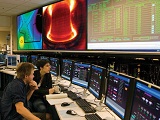ANS Fusion Energy Division statement on FY2013 energy appropriations
The American Nuclear Society's Fusion Energy Division submitted a statement on April 10 to the U.S. Senate Appropriations Committee and the U.S. Senate Subcommittee on Energy and Water Development. The statement addresses certain proposed fiscal year (FY) 2013 appropriations for the U.S. Department of Energy.
The statement is below and can be downloaded in PDF format by clicking HERE.
Dear Chairman Inouye, Vice Chairman Cochran, Chairman Feinstein and Ranking Member Alexander:
The Fusion Energy Division of the American Nuclear Society has a Statement on the proposed Department of Energy budget and its adverse effect upon the future of fusion energy research and development:
Research in nuclear fusion represents one of very few options for a long-term effort to provide a major source of energy to replace climate-changing fossil fuels and ensure America's energy security. Fusion is one of the fundamental energy sources of the universe. Providing energy from fusion is a major scientific and technological challenge-in fact, it is one of the National Academy of Engineering's Grand Challenges for Engineering-but the rewards of fusion power and the benefits of a sustainable domestic source of energy make it a challenge worth taking.
The FY-2013 budget request by the Administration endangers the United States' domestic fusion program as well as our country's scientific contributions to the ITER international project. If implemented, the FY-2013 budget reductions will deal a major blow to the U.S. fusion research program and further erode its leadership position. After years of operating on minimal budgets and essentially level funding, the U.S. fusion program cannot withstand the proposed reductions without significant negative impacts.
We urge the U.S. to consistently and adequately support the fusion research program as outlined in the Energy Policy Act of 2005 (PL 109-58, sec 971-972) and reverse this position, restoring funds to the domestic fusion program budget and, separately, fully funding this nation's promised annual ITER contribution.
The path to discover commercially viable fusion energy is one of the grand scientific challenges of our time. With ITER under construction to explore the science of burning plasmas, the world fusion program is poised to enter its final era of research. Other nations, including China, the European Union, Japan, Russia, and South Korea, are forging ahead rapidly, investing heavily in their domestic fusion programs and in educating the next generation of fusion researchers. They are fully supporting ITER as well. The U.S. has consistently led the fusion field and should continue to do so. American leadership in fusion energy would be in the best interests of the U.S. and science itself.
Sincerely,
Lee Cadwallader
Chair, Fusion Energy Division
Minami Yoda
Vice-Chair, Fusion Energy Division
cc: The Honorable Dr. Steven Chu, Secretary of Energy
The Honorable Dr. William Brinkman, Director, Office of Science, Department of Energy
Dr. Edmund Synakowski, Associate Director, Office of Fusion Energy Sciences, Department of Energy

-3 2x1.jpg)





